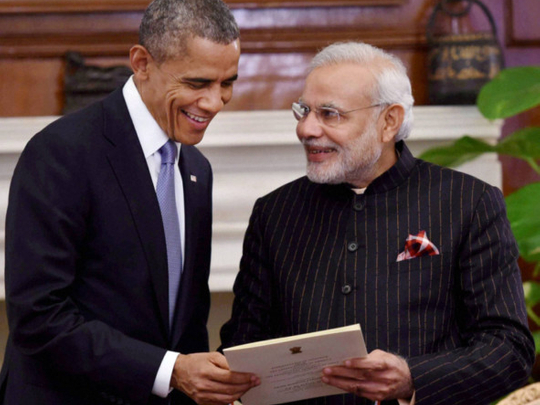
Substance and specifics are the biggest casualties of a leadership summit overshadowed by pomp, pageantry and pretentions. More so, when two leaders of the world’s oldest and largest democracies are putting up a show. Even more when a new leader is keen to announce his arrival on the world stage and another trying to make the most of the final leg of his two-term presidency.
It is not hard to define takeaways from the meeting of Indian Prime Minister Narendra Modi and US President Barrack Obama though. For Modi, who is the first right-wing leader to run a majority government, this was the biggest photo-op of his eight-month long tenure. And for Obama, who is under pressure at home due to the growing clout of Republicans and a slow economy, concessions by India on nuclear agreement opens the door for contracts worth billions for American companies.
Both leaders announced on Monday they were moving forward on India-US nuclear co-operation by removing administrative and legal hurdles obstructing the agreement signed in 2008. In a joint press conference, Obama and Modi hailed the progress on nuclear co-operation, dubbed by them as the “centrepiece” of US-India relations.
Both sides, however, were short on specifics and high on ambiguity. This deal was hampered by three sticking points: India’s nuclear liability law that allows right to sue foreign manufacturers in the eventuality of a nuclear disaster; US insistence on tracking fissile material and Indian demand for entry into Nuclear Suppliers Group or NSG.
In an apparent move to circumvent its own law, New Delhi has offered to set up a joint insurance corpus and may have agreed to give sovereign guarantees in form of a memorandum to protect American manufacturers from potential lawsuits, a point emphasised in American and British newspapers but conveniently ignored by Indian media. Similarly, there was no clarity on whether US has agreed to drop its demand to track fissile material or that New Delhi has agreed to give some legroom on this issue.
Breaking the ‘logjam’
Ben Rhodes, US Deputy National Security Advisor, said: “The Indians have moved sufficiently on these issues to give us assurances that the issues are resolved.” Indian Foreign Secretary Sujatha Singh said: “We have broken the logjam of the past few years … we have reached an understanding on two outstanding issues namely civil nuclear liability and the administrative arrangements for implementing our 123 agreement ... the deal is done.”
While more details will be revealed in the coming weeks when American manufacturers study this agreement, the importance of this summit for Modi’s political career is not lost to anyone. Monday’s events clearly showed that Obama’s trip to New Delhi was choreographed by the prime minister himself and micro-managed to raise his profile.
The first photo-op came in the morning when he went to receive Obama at the airport, a departure from protocol. As Air Force One was pulling over the tarmac, Modi noticed the ‘Beast’ blocking the view of media photographers. His officials requested US ambassador Richard Verma to have the presidential limousine removed. Verma then spoke to a Secret Service officer who refused to oblige. Modi then decided to take matters in his own hands, nudging Obama to a side before locking him in a tight embrace, all captured by eager shutterbugs.
Soon after, defence forces lined up an impressive guard of honour for the visiting dignitary at the forecourt of India’s presidential palace. The contingents of air force, army and navy were led by a woman wing commander, a first in the history of Rashtrapati Bhavan. Just days earlier, Modi had launched a campaign to protect the girl child in Haryana, a state notorious for female foeticide.
The next big photo-op came soon after the delegation-level talks and a working lunch at Hyderabad House, a palace of Nizam Osman Ali Khan now used for summits. Modi and Obama sauntered on the lush green lawns before settling down for a private chat. In a gesture some may interpret as his way of reminding people of his humble past when he sold tea to train passengers, the prime minister, in a suit striped with his own name in block letters, made tea for the president. A select group of journalists were strategically placed on a balcony as the two leaders chit chatted. At a banquet thrown by the Indian president in the evening, Obama heaped praise on Modi for his fashion sense and for fighting a crocodile, an oft repeated fable popularised by Indian media. This frank display of growing warmth was visible the next day during the Republic Day parade and a customary high-tea hosted by Indian president at Mughal Gardens.
While the jury is still out on the nuclear deal, a significant step taken by the two leaders may cause heartburn in the sub-continental neighbourhood — a hotline between Modi and Obama will soon be established. Everything else, including a vaguely-worded defence pact “to pursue co-development and co-production of specific advanced defence projects” will require more such summits and clarity.
Bobby Naqvi is the Editor of XPRESS, a sister paper of Gulf News.







